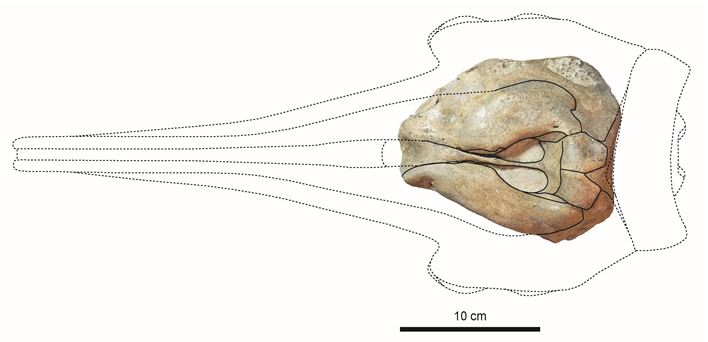Waseda researchers discover the world's oldest true dolphin species – rewrite the known fossil record

Diagram of the ancient dolphin's asymmetrical skull (by Mizuki Murakami)
In an article published in the “Journal of Vertebrate Paleontology”, Waseda Department of Earth Sciences researchers (lead author Mizuki Murakami) conclude that the specimen, which was originally categorized in 1977 as Stenella kabatensis, actually belongs to the Eodelphis kabatensis species.
This means that true dolphins existed 2 to 7 million years earlier than had been previously suggested by fossil records, and aligns with the results of molecular studies.
This work also includes the most comprehensive analysis yet of the relationships within the group of marine mammals that encompasses toothed whales such as orcas and sperm whales.
In another study, Murakami and a team of researchers also described the oldest known dolphin fossil with an asymmetrical skull, and created a new simulation of their evolution.
It has been accepted theory that dolphin ancestors earlier than 10 million years ago all had symmetrical skulls, and that asymmetry was the result of subsequent evolution. This study suggests a different evolutionary path for the marine mammals.
Media Contact
All latest news from the category: Earth Sciences
Earth Sciences (also referred to as Geosciences), which deals with basic issues surrounding our planet, plays a vital role in the area of energy and raw materials supply.
Earth Sciences comprises subjects such as geology, geography, geological informatics, paleontology, mineralogy, petrography, crystallography, geophysics, geodesy, glaciology, cartography, photogrammetry, meteorology and seismology, early-warning systems, earthquake research and polar research.
Newest articles

Bringing bio-inspired robots to life
Nebraska researcher Eric Markvicka gets NSF CAREER Award to pursue manufacture of novel materials for soft robotics and stretchable electronics. Engineers are increasingly eager to develop robots that mimic the…

Bella moths use poison to attract mates
Scientists are closer to finding out how. Pyrrolizidine alkaloids are as bitter and toxic as they are hard to pronounce. They’re produced by several different types of plants and are…

AI tool creates ‘synthetic’ images of cells
…for enhanced microscopy analysis. Observing individual cells through microscopes can reveal a range of important cell biological phenomena that frequently play a role in human diseases, but the process of…





















